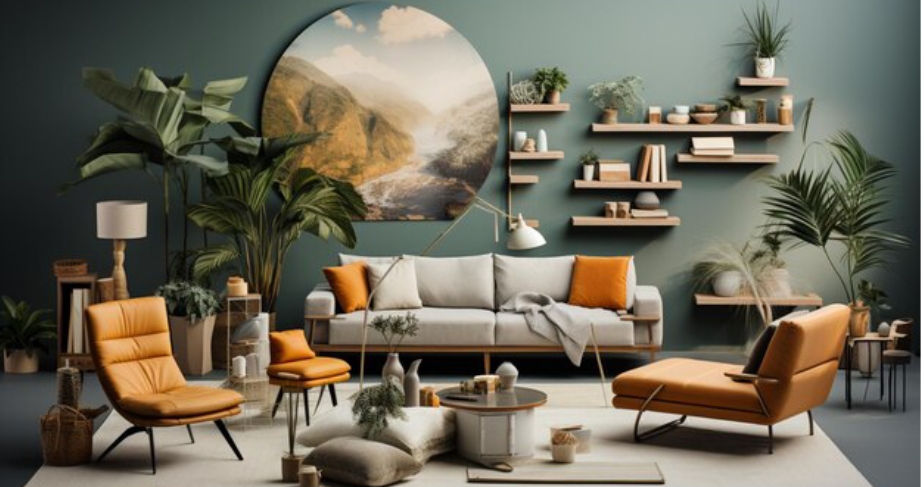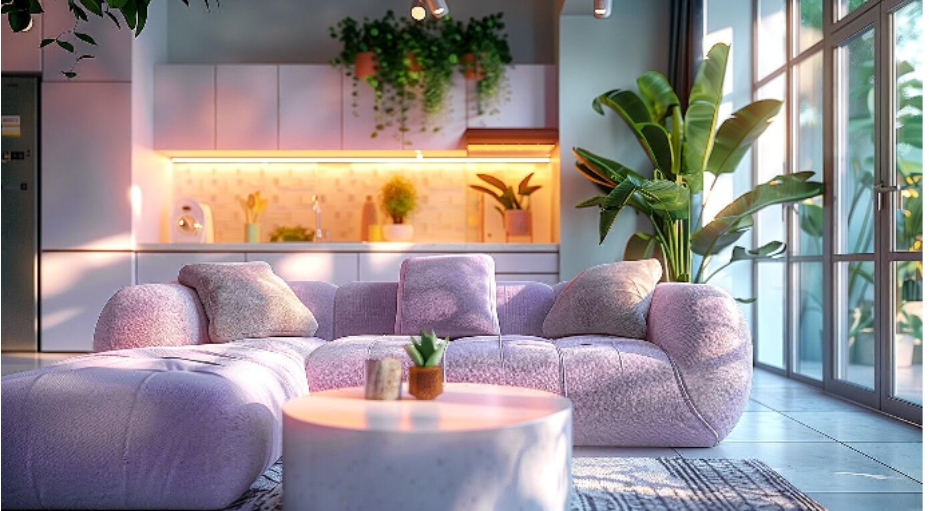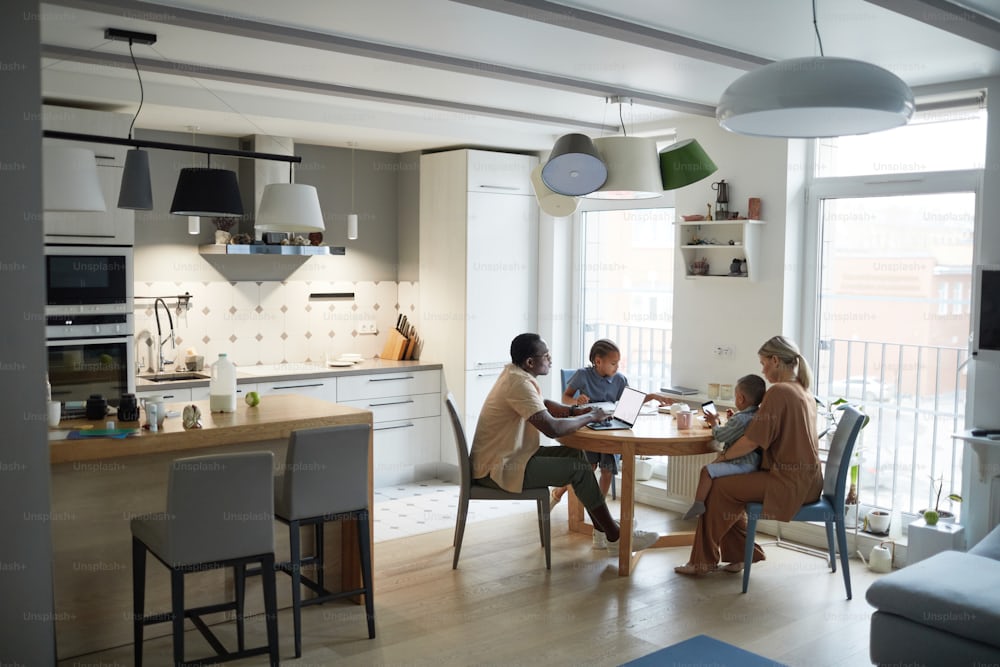I. Introduction
In recent years, there has been a significant shift towards sustainability and wellness in interior design. Homeowners are increasingly aware of the environmental impact of their choices and are opting for eco-friendly materials and energy-efficient solutions. This focus on sustainability is not just a passing trend but a fundamental change in how we approach design. Similarly, the importance of mental and physical well-being has led to the incorporation of elements that promote relaxation, productivity, and overall health within the home. For more insights on sustainable and wellness-focused design, visit homienjoy.com.

A. The Importance Of Staying Updated With Current Trends
For homeowners looking to refresh their living spaces, staying updated with current design trends is crucial. The right design choices can enhance the comfort, functionality, and value of a home. Whether you’re planning a major renovation or just looking to update a few key elements, being aware of the latest trends can provide inspiration and guidance. Moreover, keeping up with trends allows homeowners to make informed decisions, ensuring that their investments in home decor and renovations are both stylish and future-proof.
There is more pressure than ever to have a stunning and on-trend house in this day and age due to the prevalence of home design content on social media and other internet platforms. Homeowners can benefit from creating places that appeal to a wider audience and satisfy their personal preferences by recognizing and incorporating current trends. This is particularly true for those who are considering selling their house in the future.
II. Sustainable And Eco-Friendly Interior Design
In the quest for a more sustainable world, home design is increasingly reflecting our commitment to environmental stewardship. Sustainable and eco-friendly designs are no longer just trends; they are pivotal in creating homes that harmonize with nature and reduce our ecological footprint. Here’s a look at how incorporating sustainable practices into home design not only benefits the environment but also enhances the quality of life.
A. Emphasis On Sustainable Materials
One of the cornerstones of sustainable home design is the use of eco-friendly materials. Bamboo and reclaimed wood are leading the charge in this area. Bamboo, a fast-growing grass, is an excellent alternative to traditional hardwoods. Its rapid regrowth makes it a renewable resource, reducing the strain on forests and lowering carbon emissions associated with lumber production. Similarly, reclaimed wood—salvaged from old buildings, barns, and other structures—adds a unique character to home interiors while minimizing waste and the need for new materials.
Beyond the positive effect on the environment, these materials have other advantages as well. Bamboo and reclaimed wood can offer a distinctive aesthetic appeal, infusing spaces with natural beauty and warmth. They also tend to be durable and versatile, making them ideal for various applications, from flooring and cabinetry to furniture and decorative accents.
B. Energy-Efficient Appliances And Fixtures
An additional essential component of eco-friendly house design is energy efficiency. By integrating energy-efficient appliances and fixtures, homeowners can significantly reduce their energy consumption and lower their utility bills. Modern appliances, such as refrigerators, dishwashers, and washing machines, are designed to use less energy and water without compromising performance. Look for models with Energy Star certification, which guarantees they meet strict energy efficiency guidelines.
Lighting also plays a vital role in energy conservation. LED bulbs, for instance, consume up to 75% less energy than traditional incandescent bulbs and have a longer lifespan. By incorporating these fixtures into your home design, you can reduce energy usage and minimize the frequency of bulb replacements, further contributing to a greener lifestyle.
C. Benefits Of Integrating Sustainable Practices
The integration of sustainable practices into home design offers numerous benefits, extending beyond environmental impact. First and foremost, it promotes energy efficiency, which can lead to substantial cost savings on utility bills. Sustainable materials and energy-efficient technologies can also enhance the longevity and durability of your home, reducing the need for frequent repairs and replacements.
Moreover, sustainable designs often contribute to a healthier living environment. By using low-VOC paints and non-toxic materials, you create a space with improved indoor air quality, which can positively affect your well-being and comfort. Additionally, incorporating elements like natural lighting and ventilation can enhance your home’s overall ambiance and livability.
Incorporating sustainable and eco-friendly designs into your home not only helps protect the planet but also creates a healthier, more efficient living space. As these practices become more prevalent, they offer an exciting opportunity to innovate and lead by example in the journey toward a greener future.

III. Retro And Vintage Revival
In the ever-evolving world of home design, the retro and vintage revival is a trend that consistently captures our imagination. From the sleek lines of mid-century modern to the opulent details of Art Deco, these timeless styles are making a remarkable comeback. Here’s a guide to integrating these classic elements into contemporary design, along with practical tips to blend vintage charm with modern flair.
A. Tips For Blending Vintage Pieces With Modern Decor
Contrast and Complement: Mix vintage pieces with contemporary furniture to create visual interest. For example, pair a sleek, modern sofa with a vintage mid-century armchair or juxtapose a modern glass coffee table with an antique rug.
Scale and Proportion: Ensure that vintage pieces do not overwhelm the space. Select items that fit proportionally within the modern layout to maintain a balanced look.
Accessorize Wisely: Use accessories like throw pillows, lamps, and art to introduce retro elements without dominating the space. Vintage-inspired accessories can add character while still keeping the overall design fresh and current.
Color Coordination: Integrate retro colors through modern elements. For example, a contemporary sofa in a neutral shade can be paired with a vintage-inspired rug that features bold, retro patterns.
Mix Textures: Combining various textures can enhance the blend of old and new. Try pairing a modern velvet cushion with a vintage leather armchair or a sleek metal lamp with a classic wooden desk.
B. Popular Vintage Styles Making A Comeback
Mid-Century Modern: Originating from the 1940s to the 1960s, mid-century modern design is celebrated for its clean lines, functional form, and minimalistic approach. This design identifies itself by using organic shapes, tapered legs, and natural materials like leather and walnut wood in its iconic furniture pieces. The resurgence of mid-century modern is largely due to its versatility and ability to seamlessly blend with both contemporary and classic elements.
Art Deco: The Art Deco era, spanning the 1920s and 1930s, is renowned for its glamorous and extravagant aesthetic. Bold geometric patterns, vibrant colors, and opulent materials like marble and chrome are characteristics of this style. Art Deco interiors often feature intricate details, such as chevrons, zigzags, and mirrored surfaces, which create a sense of opulence and sophistication. Its revival brings a touch of vintage elegance to modern spaces.
C. Incorporating Retro Elements Into Contemporary Design
Integrating retro elements into a contemporary design can create a dynamic and visually appealing contrast. The key is to balance classic and modern features to avoid overwhelming the space. Start by choosing a focal point that embodies the retro style you love, whether it’s a vintage sofa, a retro coffee table, or an Art Deco chandelier. Use this piece as a reference point to build the rest of your design around.
Incorporating retro colors and patterns can also help blend these styles. For instance, mid-century modern often employs a palette of muted tones combined with pops of bold colors, while Art Deco utilizes rich, deep hues and metallic accents. Use these colors strategically in your wall paint, textiles, and accessories to create cohesion.
IV. Conclusion
The interior design trends of 2024 represent a harmonious blend of sustainability, technology, bold aesthetics, practicality, and personal expression. By incorporating these trends, homeowners can transform their living spaces into stylish, functional, and deeply personal sanctuaries. As we continue to evolve, so too will our homes, embracing the latest innovations while celebrating the unique characteristics that make each space truly one-of-a-kind.
Frequently Asked Questions (FAQ)
1. What will be the most popular styles of home decor in 2024?
Key trends for 2024 include eco-friendly materials, bold colors and patterns, multifunctional spaces, biophilic design, and vintage-inspired elements. Homeowners are focusing on sustainable choices and incorporating vibrant, dynamic elements into their spaces.
2. How can I incorporate eco-friendly materials into my home design?
Opt for materials like recycled glass, reclaimed wood, bamboo, and low-VOC paints. These choices reduce environmental impact and add unique character to your interiors.
3. What colors are trending in design this year?
Rich, saturated hues such as emerald green, deep blue, and burnt orange are popular. Additionally, earthy tones and neutrals remain in style for a balanced, inviting atmosphere.
4. What is biophilic design, and how can I use it in my home?
The biophilic design focuses on connecting interiors with nature. Incorporate indoor plants, natural light, and organic textures to create a calming and revitalizing environment.
5. How can I create multifunctional spaces in my home?
Use adaptable furniture, like foldable desks or modular sofas, and design areas that can easily transition from one function to another. This approach maximizes space and enhances usability.

